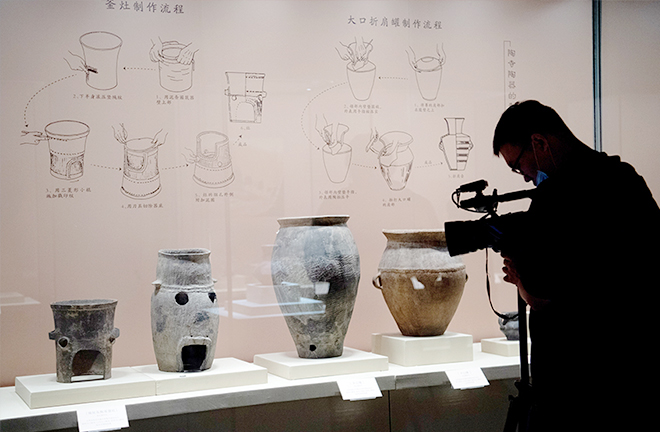Forum highlights progress in archaeology of Yellow River

Artifacts related to the Yellow River civilization Photo: IC PHOTO
At the Third Forum on the Development of the Yellow River and the Eighth Shandong-Qinghai Forum in early December in Ji’nan, Shandong Province, scholars discussed the inheritance and evolution of the Yellow River culture alongside significant archaeological discoveries in the region. The event highlighted recent research on the Yellow River basin and its critical role in Chinese civilization.
In recent years, archaeologists have made substantial progress in studying the history and culture of the Yellow River basin. These efforts have not only enhanced our understanding of ancient human development but have also provided additional evidence for the continuous history of human activity in China over millions of years. Zhang Dongju, a professor from the College of Earth and Environmental Sciences at Lanzhou University, has focused her research on Paleolithic populations and culture in the upper reaches of the Yellow River. She emphasized that this region, rich in archaeological sites, historically served as a crucial link connecting the Qinghai-Tibet Plateau, Inner Mongolian Plateau, and Loess Plateau, while facilitating exchanges between Eastern and Western cultures. Recent discoveries from the middle and late Paleolithic period and the Microlithic era are shedding light on the activities of prehistoric hunter-gatherers in the area and contributing to a deeper understanding of the origins and dispersal of modern humans.
Since 2018, the Shaanxi Provincial Institute of Archaeology (SPIA), in collaboration with the Institute of Vertebrate Paleontology and Paleoanthropology at the Chinese Academy of Sciences, Nanjing University, and local cultural heritage departments across Shaanxi, has identified over 70 Paleolithic open-air sites and collected thousands of stone artifacts on the Shaanxi side of the Shanxi-Shaanxi Gorge in the middle reaches of the Yellow River. According to Yang Junhui, an assistant research librarian at the SPIA, most of these stone tools date to the Late Pleistocene and exhibit traditional characteristics of northern China. The discovery of fine stone tools is particularly significant, as it has enriched the understanding of the Paleolithic culture in the region and provided valuable clues for future research.
The Bashan site complex in Yishui, Shandong Province, which topped the list of China’s top 10 national archaeological discoveries in 2023, comprises mid-Paleolithic open-air sites in the lower reaches of the Yellow River. Zhu Chao, vice president of the Shandong Provincial Institute of Archaeology, noted that this part of Shandong is the core and primary area of the Haidai historical and cultural region.
In recent years, a series of major archaeological findings in Shandong—including the Bashan sites in Yishui, the Zhaojia Xuyao and Tonglin sites in Linzi, and the Huang’an and Gangshang sites in Tengzhou—have further enriched and refined the study of the Haidai region’s cultural genealogy. These discoveries have outlined the region’s cultural development over the past 100,000 years, from the mid-Paleolithic era to approximately 10,000 years ago in the early Neolithic period. According to Zhu, these studies have provided important material evidence for understanding China’s million-year human history, 10,000-year cultural history, and over 5,000-year civilizational history.
The archaeology team from Shandong University (SDU) has made significant advances in cultural and civilizational studies of the Yellow River, with the goal of protecting and promoting Yellow River heritage while preserving historical and national roots. For instance, their excavation at the Jiaojia site in Zhangqiu, Ji’nan, identified the earliest-known city site in the lower reaches of the Yellow River, serving as key evidence for China’s over 5,000 years of civilizational history.
At the forum, co-hosted by the SDU and Qinghai Normal University, several representative think tank outcomes on national strategic studies of the Yellow River were unveiled, including The Yellow River Series and Vegegraphy of Shandong.
Edited by CHEN MIRONG
